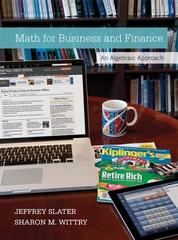Question
Microeconomics questions A special 25-year life insurance policy is issued to a life aged x and provides the following benefits: ? a lump sum of

Microeconomics questions
A special 25-year life insurance policy is issued to a life aged x and provides the
following benefits:
? a lump sum of 75,000 (payable at the end of the policy year) if death occurs
during the first 10 years
? a dependants' pension (payable in the form of an annuity certain) of 5,000 pa
payable on each remaining policy anniversary during the term (including the
25th anniversary) if death occurs after 10 years but before the end of the term of
the policy
? a pension of 7,500 pa commencing on the day after the term of the policy
expires and with payments on each subsequent policy anniversary while the
policyholder is still alive.
Write down an expression for the present value random variable of the benefits under
this policy.

Step by Step Solution
There are 3 Steps involved in it
Step: 1

Get Instant Access to Expert-Tailored Solutions
See step-by-step solutions with expert insights and AI powered tools for academic success
Step: 2

Step: 3

Ace Your Homework with AI
Get the answers you need in no time with our AI-driven, step-by-step assistance
Get Started


